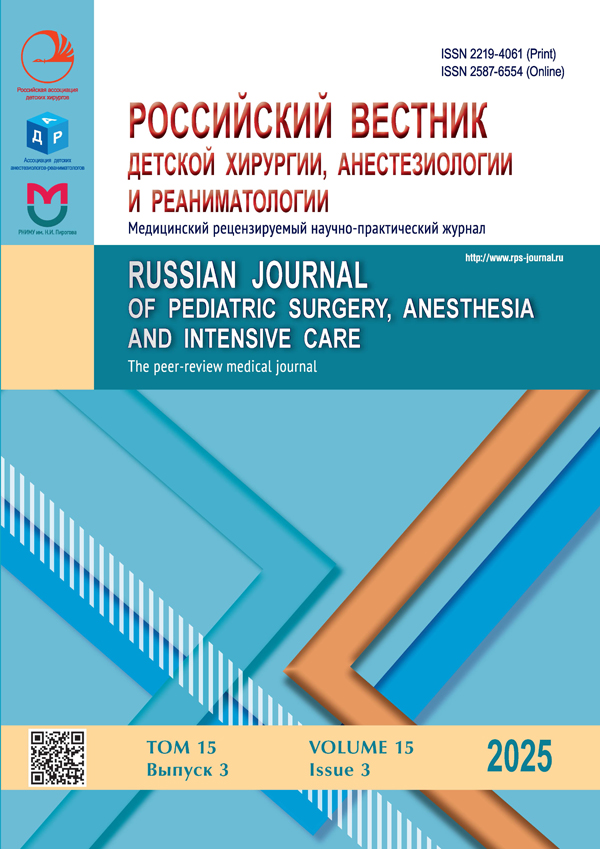Derivatives of Mullerian ducts in a phenotypically male child with unilateral nonpalpable testis: a case report
- Authors: Ekimov M.N.1,2, Tsap N.A.2, Komarova S.Y.1,2, Timoshinov M.Y.1, Pigareva A.E.3
-
Affiliations:
- Children’s City Clinical Hospital No. 9, Yekaterinburg
- Ural State Medical University
- Regional Children’s Clinical Hospital, Yekaterinburg
- Issue: Vol 15, No 3 (2025)
- Pages: 415-422
- Section: Case reports
- URL: https://journal-vniispk.ru/2219-4061/article/view/343621
- DOI: https://doi.org/10.17816/psaic1935
- EDN: https://elibrary.ru/TNXUYG
- ID: 343621
Cite item
Full Text
Abstract
Persistent Mullerian duct syndrome is a rare disorder of sex differentiation characterized by the presence of a uterus, fallopian tubes, and a vaginal outgrowth of the urogenital sinus in boys with a 46,XY karyotype. One variant of persistence of Mullerian duct derivatives in a child with male external genitalia is the mosaic chromosomal anomaly 45,X/46,XY, which clinically manifests as an inguinal hernia or cryptorchidism. This article presents a rare clinical case of failure of Mullerian duct regression in a phenotypically male child with a unilateral nonpalpable testis. A 17-month-old boy was admitted electively to the surgical department of Children’s City Clinical Hospital No. 9 in Yekaterinburg with left-sided nonpalpable testis syndrome. Diagnostic laparoscopy revealed a rudimentary uterus and left fallopian tube with a structure resembling an ovary. Postoperatively, the child underwent further evaluation (histopathological examination, hormonal status assessment, karyotyping, molecular genetic testing, and urethrocystoscopy). The clinical diagnosis was established as “disorder of sex development caused by chromosomal abnormality 45,X/46,XY, mixed gonadal dysgenesis.” In cases where persistent Mullerian ducts are detected intraoperatively, current practice is limited to biopsy of the abnormal gonad, urethrocystoscopy for visualization of the urogenital sinus, and, when possible, catheterization of the rudimentary uterus with a ureteral catheter to visualize its location in the pelvic cavity. For diagnostic confirmation, karyotype analysis, molecular genetic testing, hormonal profiling, and evaluation by a geneticist and endocrinologist are performed. The final decision regarding the child’s sex assignment, after all additional examinations, is made by a medical board in consultation with the parents.
Full Text
##article.viewOnOriginalSite##About the authors
Mikhail N. Ekimov
Children’s City Clinical Hospital No. 9, Yekaterinburg; Ural State Medical University
Author for correspondence.
Email: ekim1504@yandex.ru
ORCID iD: 0000-0003-1802-6105
SPIN-code: 2872-7908
Russian Federation, Yekaterinburg; Yekaterinburg
Natalya A. Tsap
Ural State Medical University
Email: tsapna-ekat@rambler.ru
ORCID iD: 0000-0001-9050-3629
SPIN-code: 7466-8731
MD, Dr. Sci. (Medicine), Professor
Russian Federation, YekaterinburgSvetlana Yu. Komarova
Children’s City Clinical Hospital No. 9, Yekaterinburg; Ural State Medical University
Email: urokom@yandex.ru
ORCID iD: 0000-0003-2966-2887
SPIN-code: 9411-6025
MD, Cand. Sci. (Medicine), Assistant Professor
Russian Federation, Yekaterinburg; YekaterinburgMaksim Yu. Timoshinov
Children’s City Clinical Hospital No. 9, Yekaterinburg
Email: simashinov@gmail.com
ORCID iD: 0000-0002-6397-7156
SPIN-code: 6505-1442
Russian Federation, Yekaterinburg
Anna E. Pigareva
Regional Children’s Clinical Hospital, Yekaterinburg
Email: anna-pigareva@yandex.ru
ORCID iD: 0009-0004-2503-2508
SPIN-code: 7630-8843
MD, Cand. Sci. (Medicine)
Russian Federation, YekaterinburgReferences
- Latyshev OYu, Sannikova ES, Samsonova LN, et al. Disorders of sex development 45,X/46,XY: clinical and laboratory characteristics of patients. Bulletin of Siberian Medicine. 2017;16(3):87–98. doi: 10.20538/1682-0363-2017-3-87-96 EDN: ZOWDLJ
- Huang Y-C, Lee C-T, Wu M-Z, et al. The spectrum of 45,X/46,XY mosaicism in Taiwanese children: The experience of a single center. J Formos Med Assoc. 2019;118(1-3):450–456. doi: 10.1016/j.jfma.2018.07.003
- Alkhunaizi E, Albrecht JP, Aarabi M, et al. 45,X/46,XY mosaicism: Clinical manifestations and long term follow-up. Am J Med Genet A. 2024;194(3):e63451. doi: 10.1002/ajmg.a.63451
- Kalinchenko NYu, Brovin DN, Kostrova IB, et al. Familial case of late diagnosis of Persistence of Müllerian derivatives syndrome type 1. Problems of Endocrinology. 2018;64(1):50–53. doi: 10.14341/probl8760 EDN: YVFZXF
- Kovarsky SL, Petrukhina YuV, Blokh SP, et al. Derivatives of the Müllerian ducts in abdominal cryptorchidism in children. Andrology and genital surgery. 2021;22(4):77–85. doi: 10.17650/1726-9784-2021-22-4-77-85 EDN: FCXPIO
- Stochholm K, Holmgård C, Davis SM, et al. Incidence, prevalence, age at diagnosis, and mortality in individuals with 45,X/46,XY mosaicism: A population-based registry study. Genet Med. 2024;26(1):100987. doi: 10.1016/j.gim.2023.100987
- Guzewicz L, Howell S, Crerand CE, et al. Clinical phenotype and management of individuals with mosaic monosomy X with Y chromosome material stratified by genital phenotype. Am J Med Genet A. 2021;185(5):1437–1447. doi: 10.1002/ajmg.a.62127
- Weidler EM, Pearson M, van Leeuwen K, Garvey E. Clinical management in mixed gonadal dysgenesis with chromosomal mosaicism: Considerations in newborns and adolescents. Semin Pediatr Surg. 2019;28(5):150841. doi: 10.1016/j.sempedsurg.2019.150841
- Poyrazoglu S, Bas F, Karaman B, et al. Growth and relationship of phenotypic characteristics with gonadal pathology and tumour risk in patients with 45,X/46,XY mosaicism. Clin Endocrinol (Oxf). 2021;94(6):973–979. doi: 10.1111/cen.14437
- Akinsal EC, Baydilli N, Bayramov R, Ekmekcioglu O. A rare cause of male infertility: 45,X/46,XY mosaicism. Urol Int. 2018;101(4):481–485. doi: 10.1159/000484615
- Patel SKJK, Kabir R, Nayak R, et al. A rare case of 45,X/46,X,del(Y)(q12→qter) mosaicism in an infertile male with Y chromosome microdeletion. J Reprod Infertil. 2023;24(4):293–300. doi: 10.18502/jri.v24i4.14157
Supplementary files










